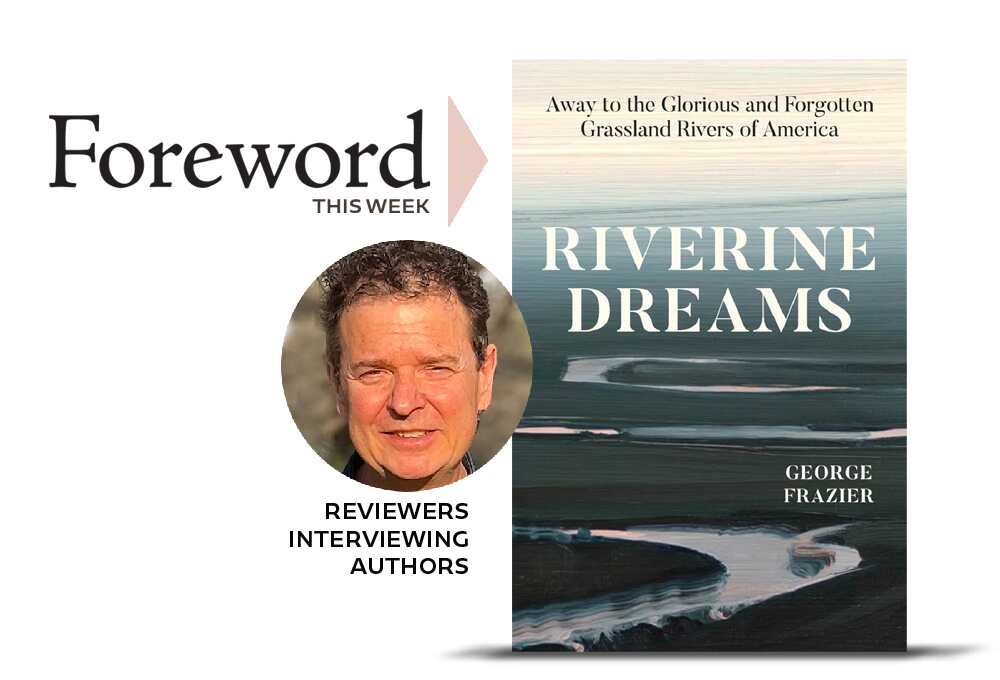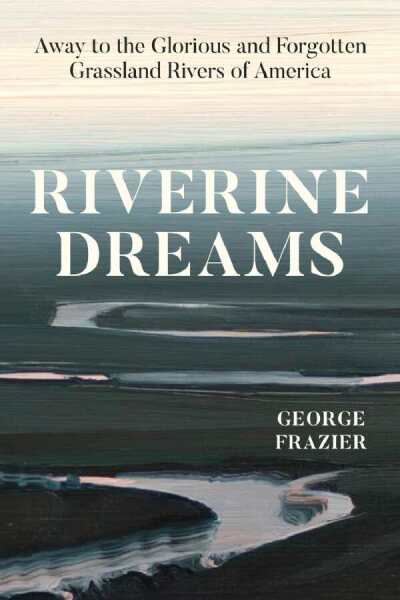Reviewer Jeff Fleischer Interviews George Frazier, Author of Riverine Dreams: Away to the Glorious and Forgotten Grassland Rivers of America

Reviewer Jeff Fleischer Interviews George Frazier, Author of Riverine Dreams: Away to the Glorious and Forgotten Grassland Rivers of America
Today’s featured book brings to mind a question we never got around to asking the smart people at the National Geographic Society: Why is there a big grassy field in the middle of America?
The prairies in North America formed as the Rocky Mountains grew taller and taller. … Once the mountains got tall enough, they blocked significant amounts of rain from falling on the east side of the mountains, creating what is called a rain shadow. This rain shadow prevented trees from growing extensively east of the mountains, and the result was the prairie landscape.

And rivers run through it—just ask George Frazier, who’s paddled many of those “glorious and forgotten grassland rivers of America” and stayed above water to write about it in his Riverine Dreams. Check out Jeff Fleischer’s review of the book in Foreword and then head over to INDIES central to discover three other fantastic Travel books.
Enjoy the conversation.
In the introduction to Riverine Dreams, you talk about a realization you had in college about the importance of preserving Midwestern prairie. How did that experience lead you to write this book?
The “aha moment” came as I drove past a beloved Kansas wild place, Elkins Prairie, just as a tractor began plowing and permanently destroying what remained of an eighty-acre remnant of deep-soil tallgrass prairie. It was home to two rare plant species and to the delights and memories of generations who had loved it. The privately owned prairie had become embroiled in politics. Recent attempts by the county and the Nature Conservancy to purchase it were mishandled, and the landowner, tired of being told what he could and couldn’t do with his land, chose to plow it under. Kansans could see both sides of the argument, but as I stood with others along the roadside watching the loss unfold, what struck me was that this wild place “mattered” every bit as much as better-known landscapes. That day began my obsession with prairies—how to preserve, protect, and experience them in a region where most remain on private land. One answer, I later discovered, lay along prairie rivers. That discovery led to Riverine Dreams. I wanted to share a new way of thinking about prairies with an audience who might not relate prairie rivers to prairies. I thought it would provide a completely new way for people to embrace Midwestern wild places and invite outdoor and wild lands enthusiasts from across the country to discover these underappreciated natural treasures.
Once you decided to focus on grassland river ecosystems, how did you choose the specific route to explore and write about?
By tapping into what I came to recognize as a “network” of people who love prairie rivers. I spoke with and interviewed hundreds of experts: biologists, paddlers, professors, anglers and hunters, wildlife specialists, water-quality professionals, authors. Each time I paddled a new river, I met people who had paddled others. Out of these connections emerged a community devoted to preserving and promoting our grassland rivers. I eventually followed a kind of route from river to river, in an order that allowed me to discover a new type of river with each journey. And by journey, I mean many trips, often returning to the same river dozens of times to keep learning more.
In exploring these areas firsthand, what most surprised you? What did you experience that you didn’t expect?
What surprised me the most was how alive, complex, and culturally layered these rivers are. Wildness persists even in the heavily farmed landscapes of the Midwest. Prairie rivers still shelter rare species, complex ecosystems, and pockets of peace and beauty—often within a bullhorn’s yell of populated areas. I met people who had quietly built their lives around these rivers—they “knew” them in ways people rarely know the land in modern times, even if they didn’t own much of it. I was struck by how much the type of prairie influenced the character of each river, and how every river had its own personality and mood. These rivers changed me, not just in how I understand riverscapes, but in how I think about my own place in the prairie landscapes where I have spent much of my life.
With hindsight, what were the most enjoyable or memorable parts of your journey through grassland river areas?
I think the most memorable part was the growing sense of synthesis and discovery as I pieced together the network of rivers and river people, realizing that the rivers of the North American interior were larger and more interconnected than I had imagined when I began. I also loved participating in the MR340 ultramarathon paddling race. Readers should know they can enjoy the book and visit these places without ever setting foot in a boat. But to report accurately, I had to paddle, and joining the tribe of people who cover 340 miles in just three days was one of the most intense experiences of my life. For more than eighty hours, I felt completely alive.
Along with your own experiences, you pack the book with history about the places you visit. How did you narrow/focus your historical research to decide what to include?
I never set out to write an exhaustive history of every grassland river. My goal was to support a sizzling narrative because the stories that have unfolded along these rivers are not just interesting footnotes; they are deep, compelling, and an overlooked but essential chapter in the history of the trans-Mississippi West. I anchored every historical detail to the larger story arc. Riverine Dreams isn’t just a catalog of facts; it’s a living story about people, places, science, prairies, and, of course, rivers. And it’s a story I believe needs to be told—urgently, and now.
You start Riverine Dreams by saying, “I believe America is at the beginning of a grassland revival.” Given the current anti-conservation shift in government, what can individuals do to make that revival happen?
When I say, “I believe America is at the beginning of a grassland revival,” I’m talking about a cultural shift that starts with awareness, connection, and personal action. Even with political headwinds, individuals can make the revival real. Spend time in grasslands and along prairie rivers so you know what’s at stake. Support local conservation groups doing the quiet, steady work of protecting land and water. Get to know the private landowners who steward native prairie. And tell the stories of these places, because the more people understand their beauty, history, and ecological value, the harder they are to ignore or destroy. Revival doesn’t begin in the government; it begins when enough of us decide these places matter.
What do you most hope the audience comes away with after reading Riverine Dreams?
I hope they come away with a new mental map of the prairie. The Great Plains and the Midwest are home to rivers and prairies that are as rich, varied, and culturally relevant as any celebrated wild landscape in America. I hope they come away with, if not an outright fever, at least a strong urge to visit these places or find their own stretches of prairie rivers to learn about and celebrate, whether they paddle, walk along them, or visit parks along their banks. I want them to see that wildness is near at hand in the least expected places. Above all, I want everyone to know that “revival” is possible, even in the face of political and ecological challenges. What matters is the love and stewardship of people who want to shape a brighter future for our grassland rivers.
Jeff Fleischer
